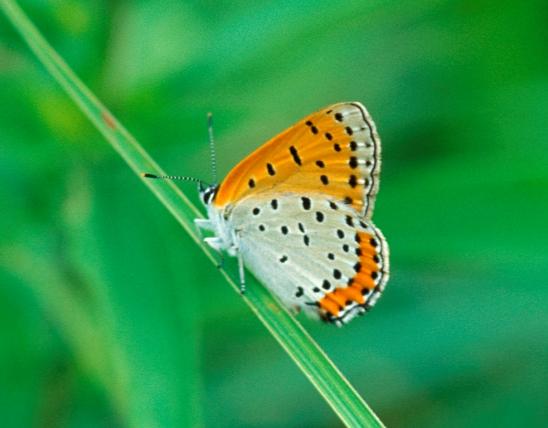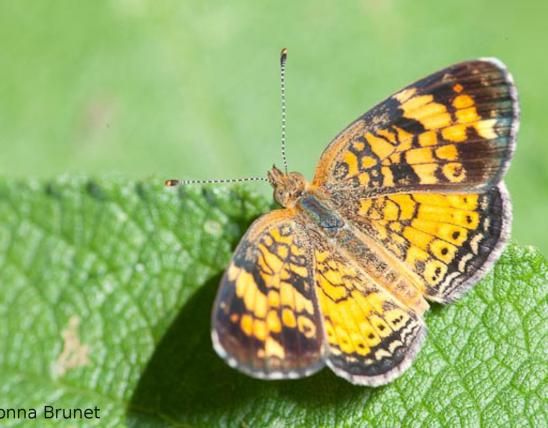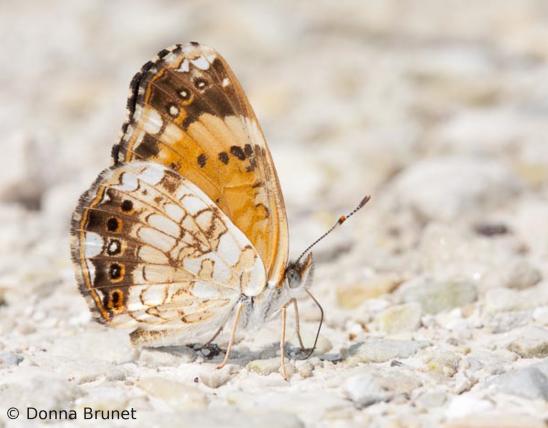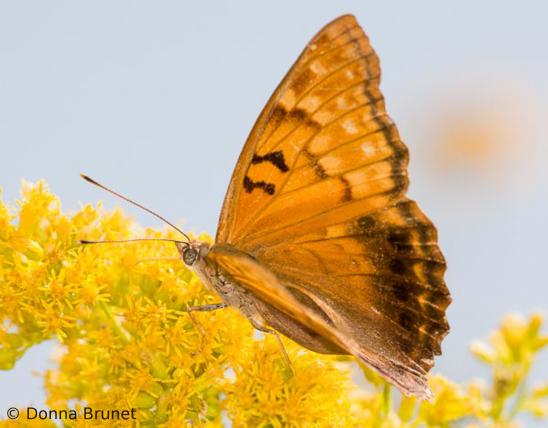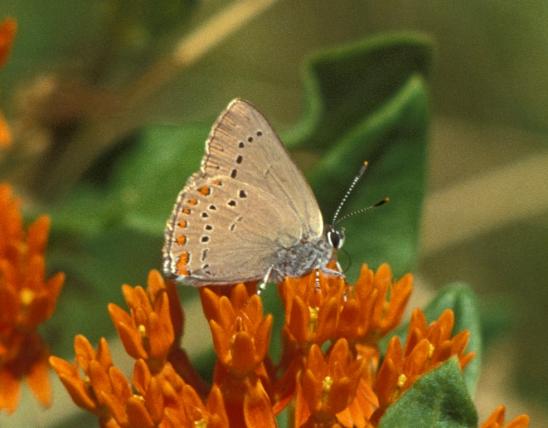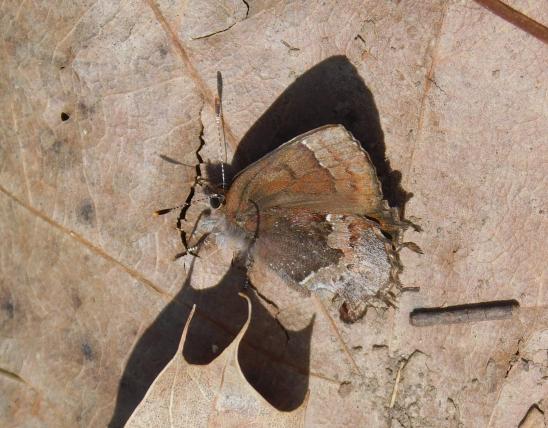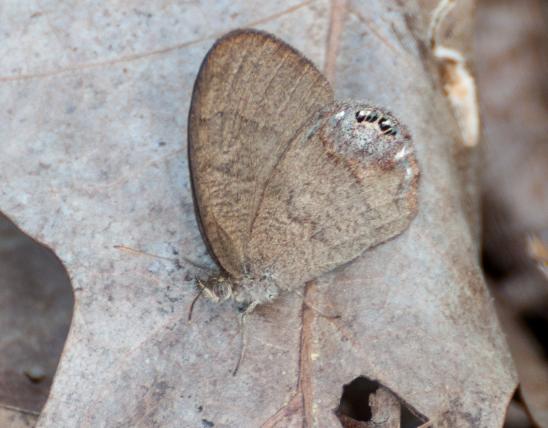
The swamp metalmark is one of only two metalmark butterflies found in Missouri; both are rare. Missouri’s metalmarks are small butterflies that are bright rusty brown above, with 2 narrow rows of small metallic spots or silvery bands on the outer half of the wings, plus a checkerboard or lacework of black bands and spots on the wings. Wing undersides are lighter orange with many small black spots and the two silvery bands on the outer half of the wings. The eyes are blue green; the antennae are finely ringed in black and white.
The swamp metalmark is the more common of our two metalmarks. It is associated with damp woods and grassy, wet, low habitats (as opposed to drier, upland sites). It is also distinguished by the upperside of the wings being bright reddish brown, lacking a truly discernable dark band down the middle. Also, the wing edges are lightly checkered (not edged with a wide orange band) (this character can be hard to distinguish). Finally, the forewings of males are faintly pointed, not rounded (this can be hard to distinguish, too).
The larvae are slug-shaped, pale green with black spots, and are covered with dense, long, white, fuzzy hairs. They look something like tiger moth caterpillars. Older caterpillars are more densely hairy than younger stages. All are very well camouflaged against the leaves of their thistle food plants, which are pale green with woolly hairs.
Similar species: Missouri has only one other species of metalmark, the northern metalmark (Calephelis borealis). It is very similar, but in our state it is known only from Barry County, in southwestern Missouri. Note, however, that there is a very recent (2020), new record of this butterfly from a prairie habitat in Lenexa, Kansas, in the southwestern part of the Kansas City metro area.
- The northern metalmark can be distinguished from the swamp metalmark by the northern’s having the upperside of both wings with wide orange edges and a definite, though not sharp-edged, darker brown band in the middle of the wings. Some specimens of this species are quite brownish, overall, on the upperside. The wing undersides are darker than on the swamp metalmark. Also, the males in this species have the forewing edges rounded (though it's hard to distinguish).
- Unlike the swamp metalmark, which is associated with damp woods and grassy, wet, low habitats, the northern metalmark is associated with dry, open woods and dry hillside meadows.
- Also take note of the two species’ different food plants. The northern metalmark’s primary larval food plant is listed as round-leaved groundsel, but it apparently also can eat other types of groundsels/ragworts (Packera spp.) and perhaps some types of fleabane daisies (Erigeron spp.).
- Like the swamp metalmark, populations of the northern metalmark are small and isolated wherever they occur, and it is vulnerable to extirpation throughout its range.
Wingspan: about ¾–1¼ inches.
In Missouri, almost all records are from the Ozark and Ozark Border regions. Some recent Missouri sightings have been from as far north as the Missouri River in central Missouri.
Habitat and Conservation
The swamp metalmark lives in small, isolated colonies in damp, brushy woods, especially along small streams and nearby wet fields, grasslands, and wetlands. Adults fly rather weakly, and they fly low to the ground, often within the tops of surrounding vegetation. They fly only short distances and frequently stop to rest on the undersides of leaves, wings spread flat.
Being weak fliers, they tend not to disperse far from their existing colonies. They may, however, travel along stream corridors, if habitat and food plants are suitable and uninterrupted.
This species occurs only in the eastern United States, in small colonies within limited, rather disconnected ranges, with most occurring in the Ozarks, the Upper Midwest, and the Ohio Valley. Missouri is at the center of the Ozark range, which includes northern Arkansas and northeastern Oklahoma. The Upper Midwest range is in southern Wisconsin, southern Michigan, and Ohio. The Ohio Valley range is centered in Kentucky. Other records include eastern Iowa and northwestern Alabama.
Wherever it occurs, the swamp metalmark usually is present only in small, localized populations and is not abundant. Habitat restoration and conservation, reduction of invasive species, and well-managed, rotational grazing for livestock, and protection from collectors are important keys to this butterfly’s survival.
Status
Breeding resident; rare; in Missouri, mostly limited to the southern half of the state.
The swamp metalmark is a species of conservation concern in Missouri, ranked as vulnerable to extirpation, due to its restricted range, relatively few populations or occurrences, recent and widespread declines, or other factors. Its global ranking is also vulnerable.
Many historic populations of this species in Missouri may have disappeared, as many of the known, isolated populations have not been seen in 20 to 40 years. Sadly, some of the established populations of swamp metalmarks in Missouri were decimated by butterfly collectors in the 1980s, and those populations — on public lands — now may no longer be present.
The closely related northern metalmark is also a Missouri species of conservation concern, ranked as critically imperiled, due to extreme rarity or because of some other factor(s) that make it especially vulnerable to extirpation from the state. Globally, it’s ranked as vulnerable.
Life Cycle
There are two broods (generations) in Missouri: the first has the adults flying primarily in June, and the second in August and early September. Each brood lasts for about two weeks. Females deposit pinkish-white turban-shaped eggs singly on the undersides of leaves of the host plants (thistles). The eggs hatch in about a week. The caterpillars feed on the undersides of leaves, scraping the tissues from the undersurfaces but leaving the upper cuticle of the leaf, creating clear, window-like spots on the leaves.
This species overwinters as partially grown caterpillars, hidden under the basal rosette of thistle leaves. In spring, the caterpillars emerge and feed again on fresh thistle foliage, then pupate. The chrysalis is attached to a flat surface (often the food plant) by a harness of silk around its middle and a patch of silk at the foot end; it is covered by the molted exoskeleton and hairs of the last larval stage, giving it the appearance of a loosely woven cocoon. After 4–10 days, the butterfly emerges.
Human Connections
This butterfly used to be considered the same thing as the northern metalmark, but in 1937 Wilbur S. McAlpine described the swamp metalmark as a separate species. McAlpine (1888–1977), an amateur but dedicated Michigan-based lepidopterist, was especially interested in the metalmarks in genus Calephelis. He published a 125-page complete scientific revision of the genus, with hand-drawn illustrations and range maps, in 1971. It’s still the best overall description of the genus. Professionally, he was an engineer, land surveyor, and draftsman. His map company produced remarkably detailed property-ownership maps and atlases of Michigan, especially of the Detroit region, that are invaluable today for historians. He was also an evangelistic solo singer.
McAlpine said about the genus name: “Calephelis is derived from Greek words meaning ‘the beautiful deceiver’ and from my experience and that of others trying to make identifications in this genus, it is certainly most appropriate.” He noted that the species all look so much alike that the only sure way to identify them was to dissect the genitalia (reproductive organs) and examine them, and the wing venation, under a microscope.
The species name, muticum, is Latin for “blunt,” which would seem to have little to do with this butterfly. In McAlpine’s original description of the species in 1937, he proposed “the name of Calephelis muticum, . . . after its food plant Cirsium muticum, the swamp thistle.” This butterfly’s principal caterpillar food is indeed the swamp thistle, and in the plant’s case, muticum is apt: it refers to the flowerhead’s phyllaries (the involucral bracts that surround the base of the flowerhead), which can be rather blunt and are not spine-tipped.
The Missouri Ozarks were the scene of breathtaking instances of irresponsible and illegal collecting. On a single site between 1979 and 1994, amateur butterfly collectors removed 284 swamp metalmarks. In fact, one person, collecting illegally without a Scientific Collecting Permit, captured and killed 65 of these butterflies on a single day, then removed 48 more a few months later. That one collector’s eventual “take” of 191 specimens is more than the total number of known specimens collected from all other states combined, from 1937 to 2005.
Ecosystem Connections
The metalmark family, the Riodinidae, contains about 1,500 species worldwide. They are most diverse and abundant in the New World tropics in South America, and many species are quite colorful. One characteristic of the family is the small, bright, shiny markings of their wings. In the past, this group was considered a subfamily of the Lycaenidae, the family that includes the blues, coppers, and hairstreaks.
These butterflies look like they were decorated with flecks of silver leaf. How do these marks look so metallic and silvery? The surfaces of their wing scales have microscopically small, angled structures that amount to tiny, mirror-like prisms. These reflect light in such a way as to make them look shiny, silvery blue, or sometimes iridescent. This is called structural coloring, which is quite different from pigmentation.
Structural coloring is a hallmark of this group, but it is not unique to it. The iridescence of fish scales, abalone shells, dogbane beetles, and deerfly eyes is caused by similar reflective structures, and not by paint-like pigments. Other examples are birds with blue and green plumage: the blue feathers of blue jays, for example, are not really “blue”; instead, they look blue because of tiny prisms that reflect only blue wavelengths of visible light. You can test this by taking a blue jay feather (or a peacock feather, green parrot feather, or other blue, green, or iridescent bird feather) and smash it with a hammer: the crushed part will turn black or brown.

























